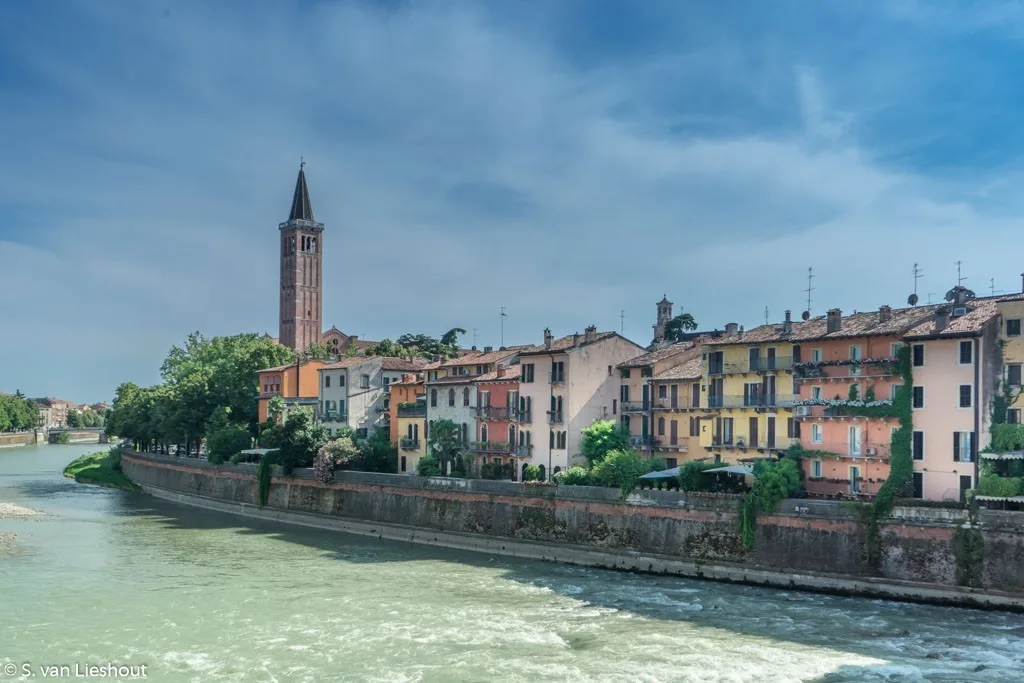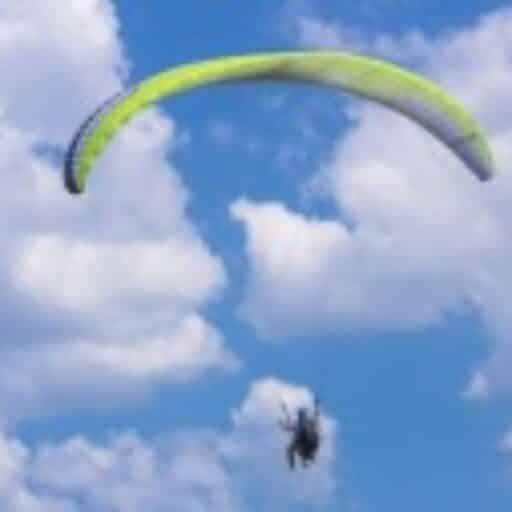
Adige river Verona
Verona in Northern Italy
Verona is a provincial capital in the north of Italy, west of Padua and Venice. The city is on the banks of the Adige river, half an hour’s drive from Lake Garda.
You will find pleasant terraces, heavenly ‘gelato’, good restaurants, the Arena and many other historical sights in the city. All interesting, of course, but for me, Verona is primarily the location of the Shakespearean drama ‘Romeo and Juliet’.
In the footsteps of Romeo & Juliet
For those who do not know the story of Romeo and Juliet, I will briefly summarize their love story below.

Shakespeare in Verona
The setting is 14th century Verona. Boy meets girl. They fall in love. The respective families dislike each other. Followed by drama in four acts (because Italy). Juliet fakes her death, Romeo dies, Juliet dies. Families make peace. End of story.
While it is doubtful that the two lovers really existed, the families probably did live as the aristocratic Montagues and Capulets feature in the city’s 14th-century annals. Also, the Florentine poet Dante Alighieri mentions them in ‘The Divine Comedy‘ (Purgatorio, Canto VI, v. 106).
Verona things to do in 48 hours
Fortunately, the untimely death of these fictional lovers was not in vain, as their love story is used by many as an inspiration to explore the city. By following in the footsteps of Romeo and Juliet, you will discover medieval Verona in 48 hours.
You will, of course, start at Julia’s birthplace.
Julia’s house
Julia’s ‘birth house’ dates back to the 13th century. It is recognizable by the crowds of tourists waiting in line at the gate for their turn to enter.
The emblem of the Capulets is on the outer facade of the house. In the centre of the courtyard stands a bronze statue of Julia. This is also the place to see Julia’s balcony, which is, in fact, a piece of harmless deception. The balcony was added during a restoration project around the 1930s to give the building a more medieval look.
The house now serves as a museum with frescoes and works of art. Julia’s bedroom is furnished with a bed used in Franco Zeffirelli’s 1968 film ‘Romeo e Giulietta’.
Address 23 Via Cappello, Verona
It is a short walk from Juliet’s house to the next point on the route.

Balcony Juliet
Romeo’s house
For what Shakespeare would no doubt have referred to as an underwhelming experience, watch out for Romeo’s house. Unfortunately, it is closed to the public, so you will have to do with the unimpressive facade.
Romeo’s house belonged to the Montecchi family. This surname bears a ‘striking’ resemblance to the name of Romeo’s family, the Montagues, evident for those who are ready to listen. Hence, this thirteenth-century house is attributed to our hero. The place is recognizable by the nameplate ‘Casa di Romeo’ in front of the building.
Address Via Arche Scaligere, 2.
Via Romeo’s house, walk to the Piazza delle Erbe to get a sense of what Verona looked like six centuries ago.
Piazza delle Erbe
Piazza delle Erbe is the heart of the city. Market stalls obscure the view a bit, but can easily be ignored as the structures around the square are impressive:
- The Mazzanti houses and the Lamberti tower are on the square’s north side. The tower was built in the year 1172 and is 84 meters high. The Mazzanti houses with extraordinary facade frescoes are among the oldest places in the city.
- On the west side is the baroque Palazzo Maffei. The top of the facade is designed as a fence with six marble deities of Hercules, Jupiter, Venus, Mercury, Apollo and Minerva. The palace dates back to the 15th century, i.e. after the Romeo & Juliet era.
- To the south is the Casa dei Mercanti (House of the Merchants, also known as the Domus Mercatorum), built in the year 1210 to house merchants. Now the building functions as a bank’s headquarters.
- The oldest monument on the square is a fountain from the year 1368. On top of the fountain is a statue called Madonna de Verona. However, the name misleads because it is a Roman sculpture from 380 AD.
- At the exit to Via Cappello stands a 14th-century column.
After the Piazza delle Erbe, it’s time for cultural entertainment at the Verona Arena. This is where the drama of Romeo and Juliet comes to life during the performance ‘Opera in Love’.

Piazza delle Erbe
Verona Arena
The Arena is a Roman amphitheatre built in the first century AD. This is one of the best-preserved structures of its kind, and it is still in use.
Originally it was meant to entertain the masses whereby gladiators fought wild animals, each other and convicted criminals. Two thousand years later, the battles continue, albeit these days mainly as play fighting. The stage is for large-scale opera performances, which take place during balmy summer evenings.
Address Piazza Bra
An evening at the opera should satisfy your bloodlust as well as any cultural cravings. End day one with a nightcap at the Piazza delle Erbe before bedtime.
Start the next day with a cappuccino on one of the many terraces. Then continue your tour by walking towards the Adige. Whilst approaching the river, admire the view of the Santa Anastasia church, which can be seen from afar. Given the importance of religion in the late Middle Ages, this church was undoubtedly also visited by Romeo and Juliet.

Arena Verona
Santa Anastasia church
St. Anastasia is the largest church in Verona. Originally the building consisted of two churches, those of Anastasius and Remigio.
In the year 1261, both churches were taken over by the Dominicans. Between the 13th and 15th centuries, these merged into one powerful church. Although the impressive façade was never completed, the new Chiesa Santa Anastasia was consecrated in 1481. The church is similar in structure to the Basilica of San Zanipolo in Venice.
Address Piazza San Anastasia.
That is culture, history and religion all done. Now it is time for ice cream. Surprisingly, this keeps us in the 14th-century because Italy already had delicious gelati even then. Look out for the stone benches across the Ponte Pietra to the side of the Sante Anastasia to enjoy your ice cream with a view.

Santa Anastasia Church
Ponte Pietra
The Ponte Pietra is a Roman arch bridge over the River Adige, the oldest bridge in Verona. The bridge was built one hundred years before Christ. In the Second World War, four arches of the bridge were blown up by retreating German troops. In 1957 the bridge was restored with the original materials.
Ponte Pietra is Italian for ‘Stone Bridge’.
After your ice cream, it is time to conclude the tour. You do that, of course, by saying goodbye to Julia.

Ponte Pietra
Juliet’s tomb in Verona
Juliet’s tomb consists of a red marble tomb in a small room, in what used to be the church of San Francesco al Corso and since 1973 functions as the Cavalcaselle Museum of Frescos.
Address Via Shakespeare, Verona
Fresco Museum of GB Cavalcaselle
The entrance ticket to the tomb also gives access to the GB Cavalcaselle Fresco Museum. Make use of the ticket, because remarkable frescoes and sculptures are exhibited here.
Address Via Shakespeare, Verona

museum frescos
Practical tips Verona
Combine a city trip to Verona with a visit to Lake Garda, the Madonna della Corona, Bergamo, Padua or Venice.
Overnight
Verona has a wide choice of hotels and apartments for every budget and taste. The city centre is easily walkable. The best thing is to spend the night in the historic heart of Verona so that you can combine it with a nighttime visit to the Verona Opera.
Browse hotels & apartments in Verona.
Transport
Verona is well connected to cities like Venice, Padua, Bergamo and Bologna by train.
This blogs explains all about the train in Italy.
The Verona Card
With the Verona 24-hour card, you have free access to most of the attractions and museums mentioned in this blog and many others. In addition, for children under 8, entry to most attractions is free.
When you buy the Verona Card, you do not have to use it immediately. Validity begins the first time the card is stamped. The card is then valid for 24 or 48 hours, depending on which pass you buy. The 48-hour version costs just five euros more than the 24-hour version, so it’s a good choice even if you plan on using it only once or twice the next day.
You can order the card online here.
In the Veneto area
Discover Valpolicella
Book a winery tour with a winemaker. Included in the tickets are:
- Tenuta Santa Maria Valverde winery tour. Admire the 17th-century cellar and private rural house with an English and Italian-speaking guide.
- Tasting a selection of handcrafter wines (Valpolicella, Ripasso and Amarone) with the winemaker.
- Light lunch with tastings from local Veronese cuisine (cheeses, salami, chutney, bread).
- Round-trip transportation from Verona city centre and Verona Porta Nuova train station (if selected).
Visit Gardaland
Gardaland is Italy’s largest amusement park on the shores of Lake Garda!
Skip the line with this ticket. Included is:
- 1 or 2-day skip-the-ticket-line entrance to Gardaland Amusement Park
- Unlimited access to all attractions
- Entrance to Parco Cavou with tropical beach vibes and water park fun rolled into one awesome attraction.
Sirmione Peninsula Tour
Go on a boat tour of Sirmione Peninsula with live commentary in English, Italian and German.
- Cruise as the sun begins to set and enjoy a bottle of prosecco (not included).
- Sail past sights like Maria Callas’s 1920s villa, the Grotte di Catullo, Boiola sulphur spring and Sirmione Castle.


More Italy
Everything you always wanted to know about the train in Italy
Where and how to buy the right train ticket, how to make a reservation, how to validate your ticket, and how to avoid a fine.
Genoa, the golden city
Genoa is a city in Liguria; the old city centre is a maze of old winding streets with lots to see and to do.
Cycle from Peschiera (Lake Garda) to Mantua with or without your family
The 44-kilometre cycling route from Peschiera on Lake Garda to Mantua is an ideal family outing throughout the year. It is lovely in spring or autumn.
Bologna, more than a great university city
Bologna university city The University of Bologna was founded almost a thousand years ago, in the year 1088. The faculties of law, medicine, and natural sciences enjoy worldwide fame. Tourism Bologna For centuries, the capital of the Emilia-Romagna region has been a...
Valpolicella, more than wine
Valpolicella more than just wine Valpolicella, a region in Northern Italy, is ideally suited to enjoy la dolce vita. Preferably outside the high season, given the crowds who flock to this part of the world in the summer. Saying that, almost all places are more...
3 x snowshoeing in northern Italy
Snowshoeing The winter wonderland of northern Italy is a great place to relax. On the snow-covered mountains, life doesn't get much better. But while it is 20º C on New Year's Day in the Swiss alps (source), I wonder how long I can, in good conscience, continue with...







